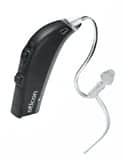Eden Prairie, Minn — Grason-Stadler has introduced CE-Chirp® and CE-Chirp Octave Band stimuli for the GSI Audera Evoked Potential Unit. The patented CE-Chirp is a unique acoustic stimulus intended to maximize Auditory Evoked Potential (AEP) amplitudes.
According to the company, the CE-Chirp creates waveforms that are as much as two times the size of 
Designed by Claus Elberling, the CE-Chirp stimulus is formulated to address the inherent time delay of the cochlea’s traveling wave characteristics. The frequencies of the CE-Chirp stimulus are adjusted so that the low and high frequencies reach their respective areas of the basilar membrane in the cochlea nearly simultaneously. This stimulus presentation results in maximizing the synchronous neural response, increasing the overall amplitude of the AEP waveform structure.
Also new to the GSI Audera Evoked Potential module is the CE-Chirp Octave Band stimuli, a derivative of the CE-Chirp. CE-Chirp Octave Band stimuli elicit robust AEP waveforms that may be used for the evaluation of frequency-specific information of the cochlea. CE-Chirp Octave Bands are available at 500, 1000, 2000, and 4000 Hz.
The company’s research suggests that larger amplitude AEP waveforms acquired with CE-Chirp stimuli may result in improved waveform replication, faster averaging time, and more robust waveforms at lower intensity levels.
SOURCE: Grason-Stadler




